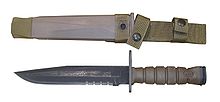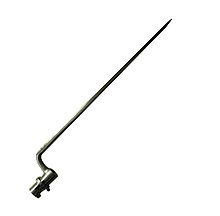bayonet
| bayonet | |
|---|---|

|
|
| Information | |
| Weapon type: | knife |
| Use: | military weapon |
| Creation time: | circa 17th century |
| Working time: | approx. 17th century - current |
| Region of origin / author: |
France |
| Distribution: | worldwide |
| Overall length: | approx. 40–80 cm, varying |
| Blade length: | from approx. 20–60 cm, varying |
| Handle: | Wood, metal, plastic |
| Lists on the subject | |
A bayonet (after the French city of Bayonne ) is a stabbing weapon that can be attached to the barrel of a firearm in the form of a long pin or a steel blade . Under the name of bayonets or side weir refers to normal today bayonets, which can be performed as an independent weapons and if necessary to the gun planted are.
description
When dismantled, the bayonet is worn on the side or on the belt like other weapons . As with the Simonow SKS-45, it can also be permanently installed on the weapon and folded out into the position of use (folding bayonet). Then it is no longer a side gun in the strict sense of the word.
Planting means attaching a stabbing weapon to a firearm with a long barrel (rifle). This gives you a second offensive or defensive weapon. In close combat it is thus possible to use the rifle as a stabbing or thrusting weapon . This form of weapon has existed since the muzzle-loading rifle ( bung bayonet ) and is continued up to today's modern rifles ( M-9 ).
A piece of metal attached to some bayonets between the blade and the nozzle or other attachment is referred to as a bayonet arm.
Attachment
The bayonet is attached to the weapon on the so-called planting device (also called bayonet holder or bayonet holder). It is the component on the weapon onto which the bayonet is pushed and locked. The planting device can be rail, bolt or rod-shaped.
The bayonet holder is a profile rail that is attached under a gun barrel and is used to attach the so-called box bayonet. On older rifle models, this rail is attached to the side of the rifle and is used to attach the mandrel on arbor bayonets.
The bayonet socket, also bayonet nipple or Aufpflanznut is a cam attached to the barrel of the rifle and designed to be round or square. This cam is used to lock the older nozzle bayonet. The cam fits into the guide groove of the bayonet and locks it on the barrel. There are other versions that are used with modern bayonets. Some modern bayonets have a locking button on the handle with which the lock can be released again. Modern bayonets usually have a Aufpflanznut on the handle knob and a ring (race) in the guard , which is put over the barrel.
Emergence
The origin and creation of the bayonet has not been clearly established. It can be developed as a hunting weapon to repel attacking animals after a missed shot or to kill it by intercepting it after it has been grazed.
Surname
The name of the weapon branch can be traced back to the southern French city of Bayonne. Legend has it that its citizens were members of irregular troops in various military conflicts in the mid-17th century. When the muskets were hot in a battle , they are said to have stuck their hunting knives into the muzzle to continue fighting .
17th and 18th centuries
Bayonets had been used in France since the mid-17th century and gradually became common in most European armies. Initially, bayonets with the handle were inserted into the gun barrel (so-called bung bayonets ) so that the musket could not fire. As early as 1669, Sébastien Le Prestre de Vauban invented bayonets that were attached to the side of the barrel with a socket - so-called socket or socket bayonets - and thus did not prevent the firing of musket balls even when they were planted. The French army has been equipped with these new bayonets since 1689. Around 1700 bayonets appeared that had an angled arm and thus made reloading possible. The most important blade shape soon developed into a stable, triangular or square shape with a length of around 40 cm.
The development of the bayonet and the increasing popularity of firearms gradually reduced the use of pikemen and pig feathers in battle. By the beginning of the 18th century, the pikeman units of most European armies had been disbanded.
19th century
From the 19th century, the spout bayonet was gradually replaced by bayonets that had their own handles - so-called knives - or saber bayonets - and were designed like knives, short pallets or sabers . "Ancestors" of these were in the 18th century attachable deer catchers , which, like these, were fixed to the pipe by means of a side ring. But since such weapons prevented the muzzle-loader from being reloaded , they only finally gained acceptance with the introduction of the breech-loader . But as early as 1840 the double-curved French Jatagan with a blade length of approx. 60 cm was exemplary. Also known is the straight Prussian fusilier side rifle from 1860, with a widened front, about 50 cm long (blade).
First and Second World War
In the First World War , bayonets reached a length of up to 50 cm. Sometimes there was fencing with these extra-long knives. Already during the trench warfare of the storm troops , rifles with fixed bayonets proved to be too unwieldy, and the bayonet was replaced by the fixed feldspade as a weapon in close combat . Both the First World War and in the Second World War was grave dagger in the grave fighting used as a melee weapon.
In the post-war period, bayonets became smaller and more manageable - today bayonets are rarely issued as standard edged weapons for infantry , but they are still possible accessories for assault rifles and are the size and weight of standard household knives. Usually only combat knives are issued. Edged weapons , however, only have a very subordinate role. The value of the bayonet in combat was debated well into the 20th century. The sometimes prominent proponents were refuted by developments in the American Civil War and the First World War. In trench warfare during the Second World War, bayonets were still used in almost all theaters of war, sometimes with success. More often, however, bayonet attacks were repulsed with considerable losses, in particular by machine gun fire.
German bayonets were marked with an S code in the mid-1930s to disguise the manufacturers. From around 1937 onwards, secrecy was abandoned and bayonets were marked on the ricasso with a fully written manufacturer and year on the back of the blade. After the start of the war, a three-letter code to identify the manufacturer was stamped on the ricasso with the two final digits of the year of manufacture.
With the development of the side of the gun 42 (SG42) with handle by the company Eickhorn from Solingen and its introduction into the armed forces set up a global development of the bayonet as mere cutting and stabbing weapon toward the aufpflanzbaren utility knife (saw, wire cutter) with shock ring a.
After the Second World War




In the Falklands War of 1982 and in the early 21st century in the war in Afghanistan since 2001 and during the occupation of Iraq from 2003-2011 , bayonets were occasionally used.
In some armed forces the bayonet is still used and bayonet close combat is also trained. The bayonet changes the position of the weapon when firing.
The German Armed Forces (e) do not use bayonets, although several versions have been developed for the G3 .
The G36 , introduced in 1997, has a bayonet mount as standard, but no special bayonets were developed. The AKM bayonet type II (M 74 and M 74/2), temporarily taken over by the NVA as “ Combat Knife , Heavy” for cost reasons , had to be modified at the retaining ring so that it could be attached without removing the flash hider. The original retaining ring was replaced by another with a larger diameter. In addition, the leather belt holder was replaced by a new one made of synthetic fibers and plastic, which is compatible with the Bundeswehr carrying system Soldat 95. This change was not made officially, but in limited numbers as a private initiative.
Eickhorn developed without official orders under the name SG2000 ( S nits g ewehr) a bayonet for the G36. It has the modified Tanto blade of the KM 2000 and is offered with (as SG2000 WC; English W ire C utter , for wire cutter) and without wire cutting function.
In April 2010, the United States Army discontinued the traditional “choreographic” training of its recruits on the bayonet in basic training , as it regards the conventional bayonet attack as increasingly irrelevant for their task profile. Nevertheless, the bayonet should continue to have its place next to the combat knife in a modified close combat training. The US Marine Corps kept training on the bayonet (with the Pugil stick ).
See also
literature
- Sebastian Thiem: Extended rifles. Hunting and military use of the bung bayonets , in: DWJ (formerly: Deutsches Waffenjournal) 7/2015, pp. 88–93
- John Norris: Fix Bayonets! Pen & Sword Military, 2016, ISBN 978-1-78159-336-3 .
Web links
- Technical terms of edged weapons from Gerhard Seifert (PDF file; 1.3 MB)
Individual evidence
- ↑ Bayonet at the digital dictionary of the German language
- ↑ Gerhard Seifert: Technical terms of edged weapons: German abc of the European bare weapons; (Cut, thrust, hit and hand weapons) , Verlag Seifert, 1981
- ↑ Overview of the second half of the article
- ↑ Michael Evans: US Army thrusts bayonet aside after centuries of faithful service. In: The Times . March 18, 2010, accessed April 8, 2010 .



